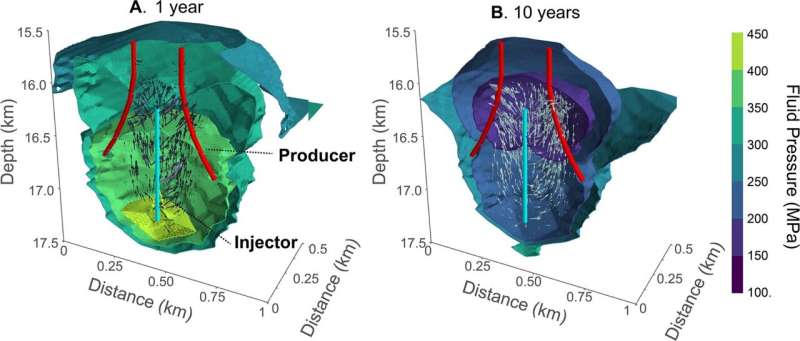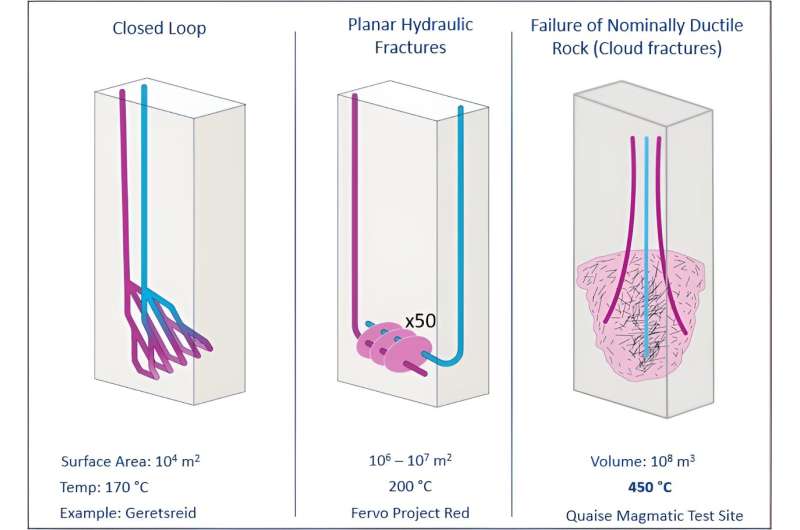Geothermal energy from the superhot rock miles below our feet has the potential to become a major player in the energy transition, but first we need to develop ways to not only access those rocks, but also extract their heat. Now a computer model sheds light on the latter, describing for the first time what happens when rock at those depths and temperatures is exposed to fluids that can eventually transfer the rocks’ heat to the surface.
Essentially, the model shows the formation of microscopic cracks creating a dense “cloud of permeability” throughout the affected rock. This is in contrast to the much larger and fewer macroscopic fractures induced by the engineered geothermal systems (EGS) in use today, which operate closer to the surface and at much lower temperatures.
Simulations using the model, which was reported in the journal Geothermal Energy, “confirm that a superhot system can deliver five to ten times more power than typically produced today from EGS systems for up to two decades,” says Trenton Cladouhos, Vice President of Geothermal Resource Development at Quaise Energy.
Cladouhos described the model and the importance of superhot rock geothermal systems in general on May 21 at the Geothermal Transition Summit, North America. His talk was titled, “Superhot Rock EGS: Methods, Challenges, and Pathways Forward.”
Authors are Samuel Scott of the Institute of Earth Sciences at the University of Iceland, Alina Yapparova of the Institute of Geochemistry and Petrology at ETH Zurich, Philipp Weis of the GFZ Potsdam German Research Center for Geosciences, and Matthew Houde, co-founder at Quaise.
Superhot rock energy
Cladouhos’ remarks focused on the challenges associated with extracting heat from far under the ground where superhot rocks sit at temperatures of more than 707 degrees Fahrenheit (375oC). Water seeping through those areas would become supercritical. This steam-like phase carries 3–4 times more energy than regular hot water, and when piped to turbines on the surface converts 2–3 times more efficiently into electricity.
Recovery of just 2% of the thermal energy stored in hot rock 3 to 10 km [2 to 6 miles] below the continental U.S. is equivalent to 2,000 times the primary U.S. energy consumption annually, according to “The Future of Geothermal Energy,” a 2006 MIT-led study on the potential for geothermal energy within the United States.
One key problem to accessing that energy is simply getting there. The drills used by the oil and gas industries aren’t designed to withstand the extreme temperatures and pressures miles down, where the mother lode of geothermal energy lies. That’s why Quaise is working on a completely new way to drill using millimeter wave energy (cousins to the microwaves many of us cook with) that can literally melt and vaporize rock.
But drilling into superhot rock is only the first challenge. Extracting the heat is a puzzle that’s at least as difficult as getting there, Cladouhos says.

Researchers around the world are working on engineered geothermal systems, essentially underground radiators or heat exchangers, that aim to do just that. There are a variety of approaches being developed—and used in the field—by companies such as Eavor and Fervo Energy, but none have been demonstrated at temperatures over about 200 oC.
“If we really want geothermal to be a game changer, we have to operate at superhot temperatures, or over 375oC,” Cladouhos says.
But little is known about what happens when superhot rock at great depth is exposed to cold water pumped down at high pressures.

